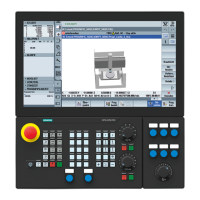Transformations
6.9 Cartesian PTP travel
Job planning
Programming Manual, 07/2010, 6FC5398-2BP40-0BA0
377
6.9 Cartesian PTP travel
Function
This function can be used to program a position in a cartesian coordinate system, however,
the movement of the machine occurs in the machine coordinates. The function can be used,
for example, when changing the position of the articulated joint, if the movement runs
through a singularity.
Note
The function can only be used meaningfully in conjunction with an active transformation.
Furthermore, "PTP travel" is only permissible in conjunction with G0 and G1.
Syntax
N... TRAORI
N... STAT='B10' TU='B100' PTP
N... CP
PTP transversal with generic 5/6-axis transformation
If point-to-point transversal is activated in the machine coordinate system
(ORIMKS) during an
active generic 5/6-axis transformation with PTP, tool orientation can be programmed both
with rotary axis positions
N... G1 X Y Z A B C
as well as with Euler and/or RPY angle vectors irrespective of the kinematics
N... ORIEULER or ORIRPY
N... G1 X Y Z A2 B2 C2
or the direction vectors
N... G1 X Y Z A3 B3 C3
are programmed. Both rotary axis interpolation, vector interpolation with large circle
interpolation
ORIVECT or interpolation of the orientation vector on a peripheral surface of a
taper
ORICONxx may be active.
Non-uniqueness of orientation with vectors
When programming the orientation with vectors, there is non-uniqueness in the rotary axis
positions available. The rotary axis positions to be approached can be selected by
programming
STAT = <...>. If
If
STAT = 0 is programmed (this is equivalent to the default setting),
the positions which are at the shortest distance from the start positions are approached. If
STAT = 1 is programmed,
the positions which are at a greater distance from the start positions are approached.
